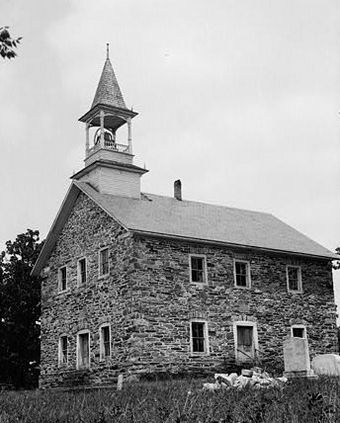Grace Evangelical and Reformed Church facts for kids
Quick facts for kids |
|
|
Grace Lower Stone Evangelical and Reformed Church
|
|
 |
|
| Location | S of Rockwell on SR 1221, near Rockwell, North Carolina |
|---|---|
| Area | 1 acre (0.40 ha) |
| Built | 1795 |
| Architectural style | Georgian |
| NRHP reference No. | 72000990 |
| Added to NRHP | January 20, 1972 |
Grace Church, also known as Lower Stone Church, is one of North Carolina's oldest churches. It started around 1745 as a Reformed congregation. The church building you see today was finished in 1795. This church is connected with the Evangelical Association.
Contents
A Look Back: Grace Church's Story
Grace Church began when German settlers moved into the Piedmont area of North Carolina. This happened mostly in the 1740s and 1750s. Many of these Germans were Lutheran, but the people who started Grace Church followed the Reformed tradition. They were sometimes called the "Calvin Congregation."
Before the current stone building, there was an older wooden church. It was known as the "Hickory Church" and was built around the mid-1750s. This early church was shared with Organ Zion Lutheran Church. It was located on Jacob Fulenwiler's land.
When Jacob Fulenwiler passed away in 1771, both churches moved. They relocated to the spot where Grace Church stands today. Organ Church then moved to its own separate location in 1774.
Building the Stone Church
Work on the current Grace Church building started after Organ Church began its own construction in 1792. Grace Church's stone building was completed in 1795.
The earliest official record of a "Meeting House" on Grace Church's land is from February 1774. A deed shows that Lorentz Lingel gave sixteen acres of land to Andrew Holtshouser and John Lippard. This land was "for the use of the Calvin congregation adjacent or belonging to the Meeting House." This proves that a log meeting house was already there before 1774.
Church Design and Features
The church is built from local granite. It has a gable roof that is 12 feet high. The building is 51 feet long and 40 feet 9 inches wide. Its walls are very thick, measuring 32 inches at ground level. They are 27 feet tall.
Grace Lower Stone Reformed Church and Organ Lutheran Church are very similar. They are almost the same size and built from the same type of rock. They also share a similar architectural style.
Inside the Church
The church floor was originally made of smooth stones and was at ground level. This stone floor stayed until 1871. That's when the current floor was put in. The first seats were simple wooden benches without backs.
The original pulpit looked like a wine glass. It stood on a base with steps leading up to it. It also had a sounding board above it to help the sound carry. This pulpit was used until 1876. At that time, new pulpit and altar pieces were made by church members.
The church also had galleries, which are like balconies, on three sides. These provided extra seating. In 1937, changes were made to create classrooms for Sunday School. Later, these partitions were removed. Now, the galleries look much like they did a long time ago.
Special Inscriptions
Above the north, south, and west doorways, there are stone tablets. These tablets have writings in German. On the south wall, there is a smaller tablet with a clock face. It has a German message that says: "In the year of Christ, 1795: with God's help." This tells us when the walls were finished.
In a church document from 1798, the name of the church is explained. It says: "This house shall be called Gnaden Kirch (Grace Church) because the eternal life and the means of grace for the same, are gifts from God, through our Lord Jesus Christ."
Dedication and Architecture
Even though the church was finished around 1795, it wasn't officially dedicated until November 1811. This happened during the time of Rev. George Boger. The church's style is Georgian colonial architecture. This style was common for stone buildings in Pennsylvania. The inside of the church is simple and whitewashed. This plain look is typical of the Reformed tradition.
In 1901, a bell tower was added to the church's roof. Grace Church is listed on the National Register of Historic Places. This means it's recognized as an important historical site.
Churchyard and Community
The church is in a peaceful setting. It is surrounded by many graves in its old churchyard. Some of the earliest families in Rowan County are buried here. You can find names like Barringer, Beaver, and Holshouser on the gravestones. Many people who are members of the church today are descendants of these early settlers.
Grace Lower Stone Church has been a "mother church." This means it helped start other Reformed churches in the area. Over its long history, many members who grew up in the church have gone on to serve their community.
Grace Church became a full member of the United Church of Christ. This group was formed in 1957 when the Evangelical and Reformed Church joined with the Congregational Christian Church. However, in 2005, Grace Church decided to leave the United Church of Christ. This was due to a disagreement about beliefs. The church chose to move closer to its older Reformed traditions.



